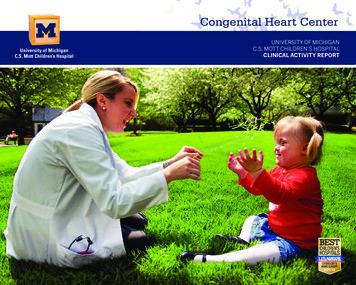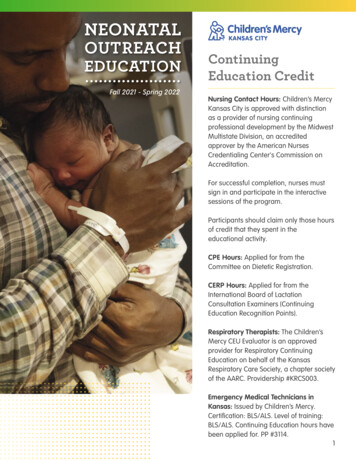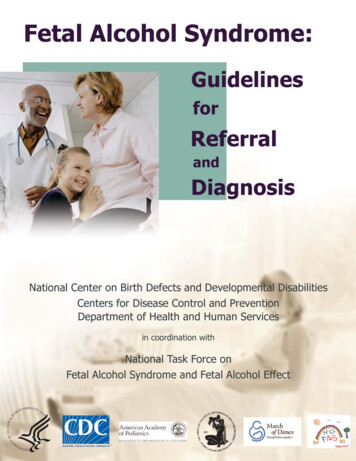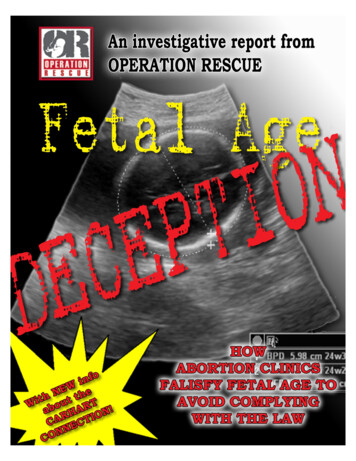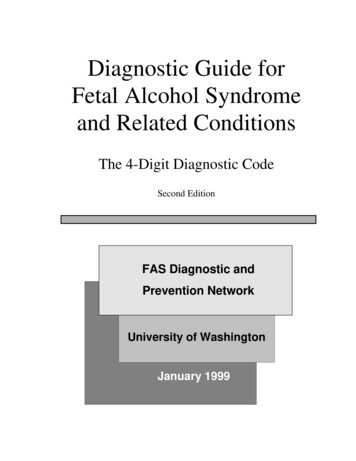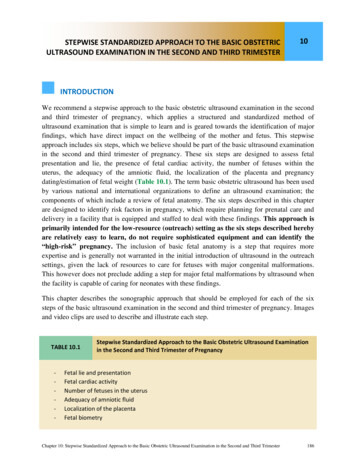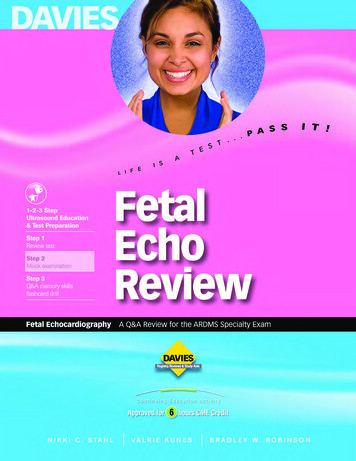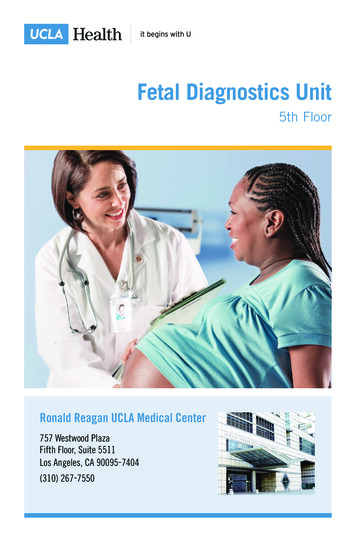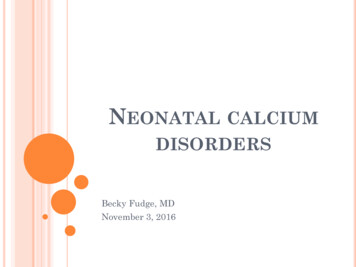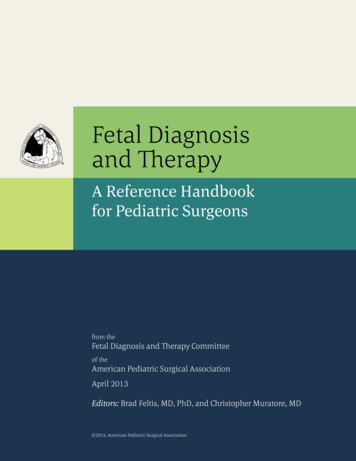
Transcription
Fetal Diagnosisand TherapyA Reference Handbookfor Pediatric Surgeonsfrom theFetal Diagnosis and Therapy Committeeof theAmerican Pediatric Surgical AssociationApril 2013Editors: Brad Feltis, MD, PhD, and Christopher Muratore, MD 2013, American Pediatric Surgical Association
CONTRIBUTORSWilliam BlockMinnesota Perinatal PhysiciansBrad FeltisChildren’s Hospitals and Clinics of Minnesota, MinneapolisTracy GrikscheitChildren’s Hospital Los AngelesShinjiro HiroseBenioff Children’s Hospital at UCSF, San FranciscoNathan HeinzerlingChildren’s Hospital of Wisconsin, MilwaukeeCorey IqbalThe Children’s Mercy Hospital, Kansas CityTimothy LeeTexas Children’s Hospital, HoustonChris MuratoreHasbro Children’s Hospital, Brown University, ProvidenceEveline H ShueBenioff Children’s Hospital at UCSF, San FranciscoShaheen TimmapuriSt. Christopher’s Hospital for Children, PhiladelphiaAmy WagnerChildren’s Hospital of Wisconsin, MilwaukeeAbdalla ZarrougMayo Clinic, RochesterACKNOWLEDGEMENTSSeveral Chapters are adapted from FI Luks, SR Carr and LP Rubin - Brown UniversityBIOMED-572ii
FOREWORDThis handbook is the culmination of the vision and efforts of those who have served on the FetalDiagnosis and Therapy Committee of the American Pediatric Surgical Association over the pastfive years. Fetal diagnosis and counseling has gradually evolved from a niche practice tosomething that most pediatric surgeons should be involved in to some extent. While very fewwill be involved in prenatal treatment, most pediatric surgeons will care for anomalies andmalformation detected prenatally. This handbook is a ready reference that provides conciseinformation about some of the more common fetal anomalies relevant to the pediatric surgeon.As the field is rapidly evolving, the contents of this handbook reflect the current knowledge andpractice. As newer diagnostic capabilities and treatment modalities are discovered, this handbookwill be updated as needed. The vision of the prior chairs of the Fetal Diagnosis and TherapyCommittee, Francois Luks and Hanmin Lee, have been brought to fruition by the efforts of thecontributors and the editors Brad Feltis and Chris Muratore. This handbook will serve as a quickreference for the pediatric surgeon about to counsel a patient and a useful educational tool for theresidents and fellows in training.Oluyinka O. Olutoye, MBChB, PhDChair, APSA 2013 Fetal Diagnosis and Therapy Committeeiiii
TABLE OF CONTENTSiiiList of contributorsiAcknowledgementsiForewordiiTable of ContentsiiiChapter 1History and Overview of Maternal-Fetal Surgery1Chapter 2Congenital Lung Lesions3Chapter 3Congenital Diaphragmatic Hernia8Chapter 4Sacrococcygeal Teratoma17Chapter 5Fetal Masses and Neoplasms19Chapter 6Myelomeningocele25Chapter 7Abdominal Wall Defects30Chapter 8Intestinal Obstruction, Atresias and Abdominal Cysts35Chapter 9Twin Gestations and Twin-to-Twin Transfusion Syndrome38iii
CHAPTER 1History and Overview of Maternal-Fetal SurgeryEveline H. Shue and Shinjiro HiroseFetal intervention for congenital anomalies has evolved from a mere concept to a medicalspecialty over the past three decades. Advances in fetal imaging and diagnosis have allowedclinicians to accurately identify complex anomalies prenatally and stratify their severity. Datathat has been accrued over the past three decades gives expectant families accurate outcomes sothey can make informed decisions about the pregnancy and delivery plans. In some cases, fetalintervention can be considered to prevent the progressive physiologic organ damage that occursfrom congenital anomalies.Results from early experiences with fetal therapy generated a movement away from anatomicrepair of congenital anomalies to physiologic manipulation of the developmental consequences(e.g., the shift from in utero repair of the CDH defect to balloon tracheal occlusion to promotelung growth). Techniques used in fetal intervention have also evolved from maximally invasive(e.g., open hysterotomy) to more minimally invasive techniques, such as fetal endoscopy, andimage-guided percutaneous procedures. Advances in surgical techniques paralleleddevelopments in fetal imaging, fetal diagnosis and the advent of maternal tocolysis to preventpreterm labor. Fetal intervention has become an important option for fetuses who wouldotherwise not survive gestation or who would endure significant morbidity and mortality afterbirth.As the fetal surgery community amasses experience with fetal intervention, an emphasis hasbeen placed on randomized controlled trials instead of retrospective clinical trials. In 1982, theInternational Fetal Medicine and Surgery Society (IFMSS) held its first annual meeting. Thissociety continues to be an important international venue. In the 1990s, trials for fetal interventionwere being performed in many different fetal treatment centers across the world. In 2005, acooperative clinical research network, the North American Fetal Therapy Network (NAFTNet),was formed to promote multi-institutional trials in the United States and Canada to study fetaldisease, develop prenatal interventions and improve outcomes. Similarly, the Eurofoetus groupwas formed in Europe to promote multicenter clinical trials and foster innovation in fetalmedicine. These international organizations of obstetricians, surgeons, perinatologists andsonologists were formed with an overarching goal to promote maternal safety while improvingoutcomes for patients with fetal anomalies.Institutional centers dedicated to fetal treatment require a collaborative team of specialists whoare dedicated to continuity of care for both the mother and the fetus. An obstetrician, who is anexpert in prenatal diagnosis, amniocentesis, chorionic villus sampling, complications ofpregnancy and family counseling, is important for management of the pregnancy. Pediatricsurgeons and neonatologists, who understand the pathophysiology behind neonatal diseases andtheir treatment after birth, are important for developing a therapeutic plan. The skills of anobstetric sonographer and pediatric radiologist are also invaluable in delineating the fetalanomaly and in guiding diagnostic and therapeutic interventions. Depending on the fetalanomaly, a pediatric cardiologist, neurologist, nephrologist, neurosurgeon, anesthesiologist orendocrinologist can also be indispensable to the fetal treatment team.11
With so many different specialties involved in fetal medicine and fetal surgery, personalityconflicts are not uncommon and many questions surface. For instance, who should perform openfetal surgery? Should it be the pediatric surgeon, who has experience repairing complexcongenital anomalies in neonates, or the obstetrician, who has experience operating on the graviduterus? There is currently no specialty that completely encompasses all aspects of care involvedin fetal surgery. Therefore, the key to a successful and productive fetal treatment program is acollaborative, multidisciplinary team, which includes an obstetrician, perinatologist, geneticist,sonologist, surgeon, neonatologist and anesthesiologist, in addition to experienced supportpersonnel (Table 1). These interactions should be formalized with a weekly multidisciplinarymeeting, where patients are discussed in depth and plans are formulated among all specialistsand personnel involved. Through these weekly interactions, care plans and interventions aremapped with consensus across all disciplines.A close working relationship between perinatal specialists is crucial to success in a fetaltreatment program. However, the institution also needs to be adequately equipped to care forfetal patients. Together this requires a high-risk obstetric unit with obstetricians who areavailable around the clock and have experience delivering patients with a recent hysterotomy, aLevel IIIC neonatal intensive care unit and an environment where research is combined withclinical care. Because fetal intervention is a new frontier, experience, success and failure must becritically analyzed, documented and shared to improve patient care and improve understanding.Over the past 30 years, fetal surgery has evolved into a multidisciplinary, collaborative medicalspecialty that strives to improve outcomes in patients diagnosed with fetal anomalies. Physiciansdedicated to fetal medicine and fetal surgery have formed a cooperative community dedicated toreporting both good and poor outcomes from fetal intervention. Through these collaborations,several multicenter, randomized, controlled clinical trials have been successfully completed. Thisfrontier could not have been established without dedicated physicians, support staff andinstitutional support.Table 1: Basic Components of the Fetal Care Team Designated team leader Care coordinator Pediatric cardiologist to perform fetal echocardiogram Fetal surgeon – usually a pediatric surgeon or a perinatologist Genetic counselor Pediatric radiologist to interpret fetal MRI Maternal fetal medicine specialist Neonatologist Obstetric anesthetist Pediatric anesthetist Social worker Ultrasonologist22
CHAPTER 2Congenital Lung LesionsTimothy LeeCongenital lung lesions (CLL) comprise a diverse spectrum of pathologic conditions. Theseconditions range from small cystic lung lesions that are asymptomatic to large lesions which maylead to a lethal outcome in utero. Many of these lesions arise along a spectrum of developmentalpathways with the most common being the congenital pulmonary airway malformation (CPAM).CPAM was formerly termed cystic adenomatoid malformation (CCAM). Bronchopulmonarysequestration (BPS) and bronchial atresia should also be considered in the differential for anyCLL. Other rare lesions such as congenital lobar emphysema, pleuropulmonary blastoma andfetal lung interstitial tumors are outside of the scope of this review. The diagnosis andmanagement of these lesions may be challenging in the prenatal period, and some may requireurgent fetal intervention. An understanding of the pathology and treatment strategies is critical inthe prenatal management of these patients.Pathophysiology of CLLsCongenital Pulmonary Airway (Cystic Adenomatoid) Malformation (CPAM)The natural history of congenital lung lesions can be quite variable. CPAMs usually arise from asingle lobe, but rarely can affect both lungs. If a single lobe is involved, the most commonlocation is in the lower lobes. These lesions may have an unpredictable growth pattern from 18to 26 weeks gestation (Bianchi, Adzick). However, after this growth period, the growth curvewill plateau and often regress. Although rare, it has been reported that these lesion may regressenough where they even disappear from the pulmonary parenchyma (Roggins, McGilvaray,Kunisaki). In regards to classification, the original Stocker classification system stratified theselesions from type 1 to type 3 based on cyst size. The new classification system includes theoriginal types (1-3) and adds types 0 and 4 (Stocker). The relevance of this classification inclinical decision making is minimal. A more relevant classification system is to classify the cystsas macrocystic ( 5mm in diameter for single or multiple cysts) or microcystic. The clinicalrelevance of this classification system lies in the differing treatment options and outcomes forthese pulmonary lesions.Bronchopulmonary SequestrationPulmonary sequestrations are areas of non-functioning lung which have no connection to thebronchial tree. These anomalies can be classified as intra-lobar or extra-lobar. An intralobarsequestration is located within the lung parenchyma, while the extralobar sequestration isseparate from the lung, including a separate pleural covering. These lesions possess a systemicarterial blood supply which often arises from the aorta, and the venous drainage may drain intothe pulmonary veins, the azygous system or the inferior vena cava. The existence of hybrid CLLswhich share characteristics of both BPS and CCAM suggest that these two pathologic entitiesshare an embryologic origin.33
Bronchial AtresiaBronchial atresia is characterized by stenosis of the bronchus at any level within the bronchialtree. Due to the stenosis, the distal lung develops progressive mucostasis and hyperinflation. Thepathology of bronchial atresia has been hypothesized to be due a vascular insult to the bronchus(Langston); however, no definitive pathologic pathway has been proven. The increasingfrequency of this diagnosis has been felt to be due to the increased use of prenatal imaging, butthese lesions are often associated with other pulmonary malformations such as CCAMs or BPS.In isolation, bronchial atresia will rarely need fetal intervention; however, mainstem bronchialatresia has been described as a fatal process. Keswani et al. reported two cases where bothfetuses died, one while during an open fetal pneumonectomy. Our experience is similar;mainstem bronchial atresia has been a fatal in utero process even with fetal intervention.Fetal Imaging for CLLsThe diagnosis and characterization of congenital lung lesion are made primarily by the use ofultrasound. The initial categorization of CLLs is as a solid or cystic mass. Cystic lesions arefurther classified as macrocystic, microcystic or hybrid lesions. Sequestrations appear as a solid,echogenic lesion. Using Doppler, the systemic feeding vessel can often be identified in theselesions.All centers recommend that fetal patients with CLL receive an initial ultrasound. Decisionsregarding the utility of fetal MRI and fetal echocardiogram are based on the interpretation of theultrasound. The CVR (see below), presence of hydrops, mediastinal shift, reversal of flow withinthe umbilical vein and abnormal cardiac echo are all useful parameters to aid in thedetermination of whether fetal therapy may be beneficial.Fetal hydrops is defined as the accumulation of fluid within two or more body cavities (ascites,pleural effusion, pericardial effusion or skin/scalp edema). Hydrops is often a harbinger of poorfetal or postnatal outcomes. Abnormal fetal echocardiogram findings can be defined as increasedor decreased cardiac output, ventricular hypertrophy, atrial or ventricular chamber dilation,cardiomegaly, significant valvular regurgitation, diastolic dysfunction or findings of heartfailure. Finally, the presence of placentomegaly ( 5cm in thickness) can be a harbinger ofimminent in utero demise.CVR (CAM Volume Ratio)The CVR or CAM volume ratio has emerged as one of the most useful tools in predictingoutcomes in prenatally diagnosed pulmonary lesions. The CVR is a measurement of tumorvolume normalized by gestational age and is calculated by using ultrasound to measure thepulmonary lesion in 3 dimensions (length, width, height). This volume is multiplied by aconstant (0.52) and divided by head circumference (which normalizes for gestational age). TheCVR equation is (L x H x W) x 0.52 / head circumference. The initial report documented that80% of fetuses with a CVR 1.6 went on to develop hydrops (Crombleholme). A more recentstudy described a similar predictive value of CVR, but with a cutoff of 2.0 (Cass). In this series,56% of fetuses with CVR 2.0 required prenatal intervention compared to 3% of the fetuses with44
CVR 2.0. Clearly, the CVR is a useful prognostic tool for CLLs, but one which is continuing tobe studied and refinedFetal TherapyThere are no absolute criteria for fetal intervention; however, fetal therapy is reserved for onlythe most severe congenital lung lesions (i.e., expect significant respiratory distress at birth orhigh risk of in utero demise). Smaller (CVR 2.0) lesions or asymptomatic (non-hydropic) largerlesions can be safely followed with weekly or bi-monthly ultrasound. Because certain CLLs canundergo rapid expansion up to 28 weeks, this is a crucial time period to monitor for any changesin the baby’s physiologic status.Maternal Mirror SyndromeA fetus with a large lung mass that has developed hydrops and placentomegaly may also placethe mother at significant risk for maternal mirror syndrome (Adzick). Mirror syndrome is amaternal complication which results in the mother’s heath state mirroring that of the fetus. Themother can develop symptoms such as hypertension, vomiting, pulmonary edema andproteinuria. Untreated, these symptoms can progress in severity and can potentially threaten thelife of the mother. The only treatment for the severe form of this syndrome is delivery of thebaby (Braun).Minimally Invasive Approaches to Symptomatic Lung LesionsMaternal Steroids (Betamethasone)The initial intervention that should be considered in patients with large, symptomatic solid ormicrocystic CLLs is the administration of prenatal steroids. This therapy has been described inseveral case series, yielding a variable but definite response (Curran, Morris). Although there arecurrently no definitive recommendations and no conclusive data to support the use of prenatalsteroids for symptomatic CLLs, several centers have independently noted lesion regression andhydrops reversal after administration. The administration of steroids is a two-dose maternalregimen of betamethasone given 24 hours apart. The exact mechanism as to how betamethasoneinduces lesion regression is not clearly defined.Cyst DrainageFor large, symptomatic macrocystic disease, most centers would employ a minimally invasiveapproach to decompress the large lesions. This can be accomplished via ultrasound-guided cystaspiration or deployment of a thoraco-amniotic shunt. Cyst aspiration quickly reduces thevolume of the CCAM; however, it is frequently only a temporizing solution, as reaccumulationof the fluid within 48-72 hours is common. The use of a thoraco-amniotic shunt has beendescribed with excellent survival rates in patients with macrocystic disease (Wilson, Schrey).Practically, shunt dislodgement after placement is common phenomenon (usually caused by thebaby) that may necessitate a repeat procedure.55
Open Fetal Surgery and EX Utero Intra Partum Treatment (EXIT)Open fetal surgery has been employed for resection of prenatally diagnosed high-risk lunglesions and can be offered when there is impending fetal demise. These procedures areconsidered on a case-by-case basis and are usually offered prior to 30 weeks gestation. Inpatients greater than 30 weeks gestation, the EXIT procedure is used to provide a transition fromfetal to post-natal life. Patients who may need an EXIT-to-resection can be symptomatic orasymptomatic in utero. Following delivery and positive pressure ventiliation, the lung mass mayincrease in size, leading to worsening of cardiac compression and cardiovascular collapse. Theresection of the chest mass, while on placental support, prevents this sequelae.REFERENCES1. Adzick NS, Harrison MR, Crombleholme TM, Flake AW, Howell LJ. Fetal lung lesions:management and outcome. Am J Obstet Gynecol. 1998 Oct;179(4):884-9.2. Bianchi DW, Crombleholme TM, D’Alton ME. (2000). Cystic adenomatoidmalformation. In: Bianchi DW, Crombleholme TM, D’Alton ME. Fetology: diagnosisand management of the fetal patient. McGraw-Hill, New York, chap 37.3. Braun T, Brauer M, Fuchs I, Czernik C, Dudenhausen JW, Henrich W, Sarioglu N.Mirror syndrome: a systematic review of fetal associated conditions, maternalpresentation and perinatal outcome. Fetal Diagn Ther. 2010;27(4):191-203.4. Cass DL, Olutoye OO, Cassady CI, Moise KJ, Johnson A, Papanna R, Lazar DA, AyresNA, Belleza-Bascon B. Prenatal diagnosis and outcome of fetal lung masses. J PediatrSurg. 2011 Feb;46(2):292-8.5. Cass DL, Olutoye OO, Ayres NA, Moise KJ Jr, Altman CA, Johnson A, Cassady CI,Lazar DA, Lee TC, Lantin MR. Defining hydrops and indications for open fetal surgeryfor fetuses with lung masses and vascular tumors. Pediatr Surg. 2012 Jan;47(1):40-5.6. Crombleholme TM, Coleman B, Hedrick H, Liechty K, Howell L, Flake AW, JohnsonM, Adzick NS. Cystic adenomatoid malformation volume ratio predicts outcome inprenatally diagnosed cystic adenomatoid malformation of the lung. J Pediatr Surg. 2002Mar;37(3):331-8.7. Curran PF, Jelin EB, Rand L, Hirose S, Feldstein VA, Goldstein RB, Lee H. Prenatalsteroids for microcystic congenital cystic adenomatoid malformations. J Pediatr Surg.2010 Jan;45(1):145-50.8. Keswani SG, Crombleholme TM, Pawel BR, Johnson MP, Flake AW, Hedrick HL,Howell LJ, Wilson RD, Davis GH, Adzick NS. Prenatal diagnosis and management ofmainstem bronchial atresia. Fetal Diagn Ther. 2005 Jan-Feb;20(1):74-8.9. Kunisaki SM, Barnewolt CE, Estroff JA, Ward VL, Nemes LP, Fauza DO, Jennings,RW. Large fetal congenital cystic adenomatoid malformations: growth trends and patientsurvival. J Pediatr Surg. 2007 Feb;42(2):404-10.10. Langston C. New concepts in the pathology of congenital lung malformations. SeminPediatr Surg. 12:17-37, 2003.11. MacGillivray TE, Harrison MR, Goldstein RB, Adzick NS, et al. (1993) Disappearingfetal lung lesions. J Pediatr Surg. 28:1321–1325.66
12. Marwan A, Crombleholme TM. The EXIT procedure: principles, pitfalls, and progress.Semin Pediatr Surg. 2006 May;15(2):107-15.13. Roggin KK, Breuer CK, Carr SR, Hansen K, et al. (2000) The unpredictable character ofcongenital cystic lung lesions. J Pediatr Surg. 35:801–805.14. Schrey S, Kelly EN, Langer JC, Davies GA, Windrim R, Seaward PG, Ryan G. Fetalthoracoamniotic shunting for large macrocystic congenital cystic adenomatoidmalformations of the lung. Ultrasound Obstet Gynecol. 2012 May;39(5):515-20.15. Stocker JT. Congenital pulmonary airway malformation: A new name and an expandedclassification of congenital cystic adenomatoid malformation of the lung. Histopathology.2002;41(suppl 2):424-431.16. Wilson RD, Baxter JK, Johnson MP, King M, Kasperski S, Crombleholme TM, FlakeAW, Hedrick HL, Howell LJ, Adzick NS. Thoracoamniotic shunts: fetal treatment ofpleural effusions and congenital cystic adenomatoid malformations. Fetal Diagn Ther.2004 Sep-Oct;19(5):413-20.77
CHAPTER 3Congenital Diaphragmatic HerniaCorey W. IqbalIntroductionThe incidence of congenital diaphragmatic hernia (CDH) is estimated to be between 1 in 2,200 to5,000 live births1-2; however, the true incidence is likely closer to 1 in 2,200 as this defect can beassociated with intra-uterine fetal demise and stillborns which are difficult to capture inepidemiologic studies2-3. Determining an accurate mortality rate for CDH is also a moving targetgiven variable referral patterns that tend to triage sicker babies to tertiary referral centers; thebest available estimates have reported mortality rates as high as 75% for prenatally diagnosedCDH4-5. Most other estimates put the mortality rate around 50%4-6. CDH is being morecommonly diagnosed antenatally (usually by 25 weeks gestation) with early prenatal care,enhanced imaging modalities and a heightened awareness of findings associated with CDH.While advances in medical management of CDH have improved outcomes in the last century,our ability for prenatal diagnosis of CDH has not affected the grim prognosis associated withdefects that result in fatal pulmonary hypertension.The role of fetal interventions for CDH is still an area of intense investigation and currently isnot widely available; however, the pediatric surgeon will be asked to counsel families caring forpregnancies complicated by CDH. The diagnosis of CDH has significant immediate implicationsfor the family regarding delivery at a tertiary referral center, the need for neonatal intensive care,the decision for extracorporeal membrane oxygenation (ECMO) and other aggressiveresuscitative measures, and even termination of the pregnancy. Therefore, it is critical thatpediatric surgeons are capable of interpreting antenatal studies and counseling families so theycan make informed decisions regarding the pregnancy.Diagnostic Modalities and Prognostic IndicatorsFetal UltrasonographyUltrasonography (US) is routinely performed during the prenatal period. Polyhydramnios hasbeen implicated in CDH from kinking of the stomach, as well as mediastinal compression on theesophagus impairing the fetus’ ability to swallow amniotic fluid7. Once the suspicion for CDHhas been raised, a more thorough investigation of the thorax can be undertaken to identifyherniated abdominal contents. It is widely accepted that the presence of abdominal structuresseen at the same level as the four-chamber heart view on US confirms the presence of adiaphragmatic hernia1. Abdominal viscera, visualized above the tip of the scapula, can also beused as a reference point1. In some cases, US can visualize the defect in the diaphragm, makingthe diagnosis very clear.The presence of liver herniation reproducibly predicts a worse outcome for CDH8-9; therefore,position of the fetal liver should be assessed during fetal US. Kinking of the sinus venosus andthe presence of left lateral segment portal veins above the diaphragm are the most reliable88
indicators of liver herniation into the left chest10. For right-sided defects, the presence of thegallbladder above the level of the diaphragm can confirm the location of the liver2.The lung-to-head ratio (LHR) is another important prognostic indicator. It is obtained bymeasuring the right lung area at the level of the four-chamber view of the heart and dividing bythe head circumference. In multiple studies, an LHR 0.6 was associated with 100% mortality,while an LHR 1.35 was associated with 100% survival11-14. When measured correctly, the LHRcan be invaluable; however, reproducibility has limited its application. In fact, there are nowthree different standardized methods for obtaining the LHR which have different survivaloutcomes2. Regardless, the LHR (or variants of the LHR) has been widely accepted.Another factor affecting LHR is the gestational age of the fetus. The fetal lung and head grow atdifferent rates, especially up to 32 weeks gestation when lung growth begins to level off relativeto the head circumference9. This prompted investigators to propose the observed-to-expectedratio for LHR (O/E LHR) based on what the mean expected LHR would be for a specificgestational age in fetuses not affected by CDH15-16. As lung growth plateaus, there is a decreasein the O/E LHR. For example, an LHR of 1.0 correlates with an O/E LHR of 32% at 23 weeksgestation, and an O/E LHR of 23% at 33 weeks gestation for a left-sided defect17. In the originaldescription of the O/E LHR for left-sided defects, O/E LHR of 25% was associated with an18% survival; O/E LHR of 26-45% was associated with a 66% survival; and O/E LHR of 45%was associated with an 89% survival15,18.Fetal Magnetic Resonance ImagingFetal magnetic resonance imaging (MRI) is an emerging imaging modality in the work-up ofspecific prenatally diagnosed congenital anomalies including CDH where it has primarily beenstudied in measuring lung volumes for antenatal prognostication. The most importantmeasurement obtained, and studied, by MRI is the percent predicted lung volume (PPLV)—alsoknown as the observed to expected fetal lung volume (O/E FLV)19-20. This calculation is made bysubtracting the mediastinal volume from the thoracic volume to determine the expected lungvolume. The actual lung volume is then measured and divided by the expected lung volume tocreate a percentage19.Exactly how the PPLV should be interpreted is not agreed upon. In one study, 15% appeared tobe the determinant of survival, where those with a PPLV 20% had 100% survival, whereas aPPLV of 15% was associated with only 40% survival21. In another study, the cutoff appeared tobe 25% where PPLV 25% was associated with a 13% survival, and a PPLV 35% wasassociated with an 83% survival20; however, some have reported that PPLV is inferior to LHR inpredicting outcomes2. Furthermore, LHR can be obtained by US and does not require a fetalMRI. In fact, MRI is not a routine part of the work-up for CDH at all fetal treatment centers12.Other groups have looked at the raw fetal lung volume (FLV) as a prognostic indicator22-23. In aseries of FLV obtained via MRI at 34-35 weeks gestation, the investigators reported thatsurvivors had a mean FLV of 35ml, those requiring ECMO had a mean FLV of 18ml, and nonsurvivors had a mean FLV of 9ml23.The group from CHOP has also reported that the presence of the liver-up on MRI, as well as thepercentage of herniated liver, were also prognostic by multivariate analysis. Liver-up is widelyaccepted as a poor prognostic indicator. In their series, liver-up was associated with 45%99
survival, whereas liver-down was associated with 94% survival28. Again, this can also bedetermined by US and does not necessitate a fetal MRI; however, they also looked at herniatedliver volumes as determined by fetal MRI and found that survivors had a mean 17% of liverherniated compared to non-survivors who had a mean 28% liver herniated (p 0.004)28.Imaging for Associated AnomaliesIt is important that an assessment be made to determine if there are any associated anomalies, asthese have a significant, negative impact on survival. In fact, 95% of stillborns with CDH havean associated anomaly24. These anomalies can include congenital heart disease, genitourinaryabnormalities, intestinal atresia, bronchopulmonary sequestrations and neurologic defects—mostof which can be detected through prenatal US2. Further delineation of suspected anomalies maybe better assessed by fetal MRI, especially if this information would impact the management ofthe pregnancy.Amniocentesis should be offered for karyotyping, as well as comparative genomic hybridizationmicroarray, to identify chromosomal abnormalities. This information may be helpful for familiesmaking decisions regarding the pregnancy and post-natal care. Up to 20% will have achromosomal abnormality such as trisomy 21, trisomy 18 or trisomy 132. CDH can also occur inassociation with multiple syndromes including Beckwith-Wiedemann, Fryns and Pierre-Robin.Lastly, since most fetal interventions are investigational, normal chrom
Techniques used in fetal intervention have also evolved from maximally invasive (e.g., open hysterotomy) to more minimally invasive techniques, such as fetal endoscopy, and image-guided percutaneous procedures. Advances in surgical techniques paralleled developments in fetal imaging, fetal diagnosis and the advent of maternal tocolysis to prevent

